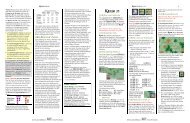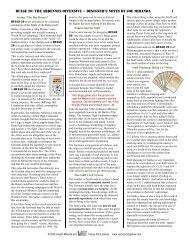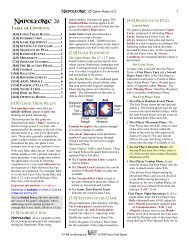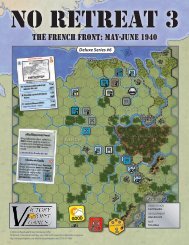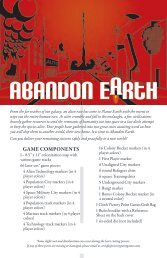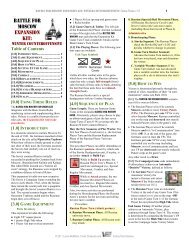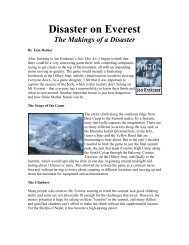Arduous rules - Victory Point Games
Arduous rules - Victory Point Games
Arduous rules - Victory Point Games
You also want an ePaper? Increase the reach of your titles
YUMPU automatically turns print PDFs into web optimized ePapers that Google loves.
The <strong>Arduous</strong> Beginning Game Rules v1.0 2<br />
Infantry divisions. Collectively, these<br />
unit types are referred to as “Tank.”<br />
Unit Size Symbols<br />
XXX<br />
Corps<br />
XXXX<br />
Army<br />
Combat Strength measures a unit’s value<br />
when attacking and defending in a Battle as<br />
expressed in Strength <strong>Point</strong>s; higher<br />
numbers are stronger. Soviet Mechanized<br />
units have a separate Combat Strength that<br />
they use when attacking (an “Attack<br />
Strength”) and defending (a “Defense<br />
Strength”).<br />
Movement Allowance determines how far<br />
the unit can move at each opportunity as<br />
expressed in Movement <strong>Point</strong>s.<br />
Unit Size affects stacking (i.e., having<br />
more than one unit in a hex).<br />
Unit ID (identification) is included purely<br />
for historical interest and has no effect on<br />
game play.<br />
All ground units have two sides: most<br />
ground combat units have a full-strength<br />
(front, two-step) side and a reducedstrength<br />
(back, one-step) side (in a<br />
different shade of color for easy recognition<br />
during play) that is half the Combat<br />
Strength of its full-strength side (rounded<br />
down). Soviet Mechanized units and the<br />
Brest Garrison unit have only a reducedstrength<br />
(one-step) side.<br />
Air Support Markers<br />
The German player has markers to indicate<br />
his use of air support in attacks. These are<br />
not ground units; they are placed (not<br />
moved) and stack (temporarily) for “free.”<br />
Number of Column Shifts<br />
when supporting an attack<br />
ID (FK II)<br />
The six-sided die (H), which players must<br />
provide, is used only with the Combat<br />
Results Table to determine the result of<br />
attacks. The die has nothing to do with the<br />
movement of units.<br />
[4.0] SEQUENCE OF PLAY<br />
Game Length: There are seven Game<br />
Turns in The <strong>Arduous</strong> Beginning.<br />
Time Scale: Each Game Turn represents<br />
approximately seven or eight days.<br />
How the Turns Work: Each turn is<br />
divided into nine parts or “Phases” that are<br />
performed in the exact order listed below.<br />
All actions in one Phase must be finished<br />
before the next Phase can begin.<br />
The first four Phases comprise the German<br />
“Player Turn;” the next four comprise the<br />
Soviet Player Turn.<br />
Procedure<br />
German Player Turn<br />
1. German Build-Up Phase. The Germans<br />
receive replacements.<br />
2. German Movement Phase. All German<br />
units can move.<br />
3. German Combat Phase. All German<br />
units can attack.<br />
4. German Special Movement Phase. All<br />
German Panzer and Reserve units (only)<br />
can move again.<br />
Soviet Player Turn<br />
5. Soviet Build-Up Phase. The Soviets<br />
receive replacements and reinforcements.<br />
6. Soviet Special Movement Phase. All<br />
Soviet Mechanized and Reserve units<br />
(only) can move (and Reserve units can<br />
use Soviet Rail Movement).<br />
7. Soviet Combat Phase. All Soviet units<br />
can attack.<br />
8. Soviet Movement Phase. All Soviet<br />
units can move. Those that moved in<br />
Phase 6 can move again.<br />
Administrative<br />
9. Housekeeping Phase. Advance the<br />
Game Turn marker or, if the last turn was<br />
played, stop and determine the winner.<br />
[5.0] HOW TO WIN<br />
The German player wins by<br />
controlling all 12 city hexes on<br />
the map at the end of the Game<br />
Turn 7. The Soviet player wins<br />
if the Germans only control 10<br />
or fewer cities. If the Germans control 11<br />
cities (i.e., all but one), the game is a draw.<br />
A player “controls” a city if one of his<br />
units was the last one to pass through or<br />
occupy that hex. The Soviets control all<br />
cities at the beginning of the game.<br />
The Germans must “sweep the table” by<br />
mid-August to have a good chance of<br />
winning the war against the Soviet Union in<br />
1941. Failing this, the German offensive is<br />
likely to become bogged down, as it<br />
historically did, and continue into winter.<br />
[6.0] SETTING UP THE GAME<br />
Procedure<br />
1. Place the Game Turn marker<br />
on the 1 box of the Game Turn<br />
Track. Turn all ten Soviet<br />
Mechanized Corps to their untried side<br />
(the side with a question<br />
mark for strength) and mix<br />
them thoroughly so neither<br />
player knows their strength.<br />
2. Place full-strength Soviet armies and<br />
untried Soviet Mechanized Corps on the<br />
map (as shown there with tiny symbols):<br />
Minsk: 1 Infantry Army, 1 Mechanized<br />
Corps<br />
Baranovichi: 1 Mechanized Corps<br />
Velikie-Luki: 1 Infantry Army<br />
Gomel: 1 Infantry Army, 1 Mechanized<br />
Corps<br />
Brest: Its (3-4) Garrison Infantry<br />
Corps<br />
3. Place three (3) Soviet Infantry<br />
armies and four (4) Soviet Mechanized<br />
Corps in the seven front line hexes with<br />
red stars (), one unit per hex.<br />
Important: Armies may not be placed in<br />
hexes adjacent to another Army.<br />
4. The remaining Soviet units (four armies<br />
and three Mechanized Corps) are placed<br />
as indicated on the Game Turn Track to<br />
arrive as reinforcements (11.0).<br />
5. The German then sets up two fullstrength<br />
German units on each hex<br />
containing a black cross (!).<br />
6. The German player commences the first<br />
Game Turn with the German Combat<br />
Phase (skipping the German Build-Up<br />
and Movement Phases*). The game then<br />
proceeds according to the Sequence of<br />
Play (Rule 4.0) until the last Game Turn<br />
is completed. Note the special German<br />
First Turn Surprise Attack Rule (9.5).<br />
*Since all German units begin at full<br />
strength, and are physically placed in their<br />
starting positions, the German player needs<br />
neither Replacements nor Regular<br />
Movement on Game Turn 1.<br />
[7.0] ZONES OF CONTROL<br />
General Rule<br />
Each unit has a Zone<br />
of Control (“ZOC”)<br />
that consists of the<br />
six hexes surrounding<br />
it (see diagram),<br />
including hexes<br />
occupied by enemy<br />
units. Enemy Zones<br />
of Control have important effects on<br />
movement, combat, and replacements.<br />
[7.1] Movement Effect: A unit entering an<br />
enemy Zone of Control (“EZOC”) must<br />
immediately end its movement for that<br />
© 2009 Frank Chadwick and <strong>Victory</strong> <strong>Point</strong> <strong>Games</strong>



